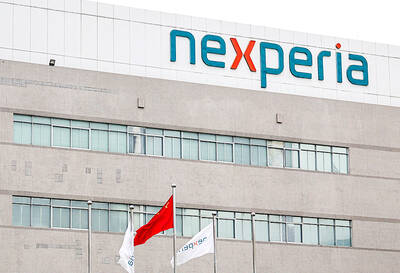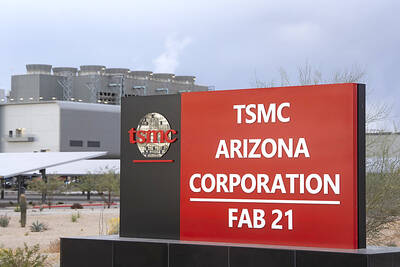Worldwide semiconductor manufacturing equipment billings for the first quarter dropped 19 percent annually amid an industry slump, but Taiwan bucked the downtrend with billings soaring 68 percent year-on-year, international trade group SEMI said yesterday.
Global semiconductor manufacturing equipment billings for the quarter fell to US$13.79 billion, from US$16.99 billion a year earlier, according to data gathered by SEMI and the Semiconductor Equipment Association of Japan from 80 global equipment suppliers.
On a quarterly basis, billings from worldwide semiconductor firms shrank 8 percent from US$14.96 billion, the data showed.
However, billings from Taiwan jumped to US$3.81 billion, compared with US$2.27 billion in the corresponding period last year, SEMI said.
That figure represented a growth of 36 percent from US$2.81 billion of semiconductor equipment shipped to Taiwanese chipmakers a quarter earlier, the data showed.
That made Taiwan the world’s biggest semiconductor equipment spender, surpassing South Korea’s US$2.89 billion.
China ranked third with US$2.36 billion in billings, followed by North America at US$1.67 billion and then Japan, with US$1.55 billion, the data showed.
Taiwan Semiconductor Manufacturing Co (TSMC, 台積電) was the biggest contributor to Taiwan’s billings. The world’s largest contract chipmaker has budgeted record capital spending of between US$10 billion and US$11 billion on new manufacturing equipment for this year.
Most of the spending would go toward advanced technologies, including the 7-nanometer (nm) and next-generation 5nm processes, TSMC has said.
TSMC is expected to be the world’s first chipmaker to offer 5nm technology when the company ramps up production in the first quarter of next year, extending its leadership in offering 7nm technology, it said.
TSMC last week said that it has invested US$50 billion on capacity expansion over the past five years to solidify its technological leadership and fuel revenue growth.
Two weeks ago, North America-based manufacturers of semiconductor equipment reported a 4.7 percent monthly growth in worldwide billings to US$1.91 billion for April, marking the first monthly growth since December last year.
However, SEMI said that it was premature to call the upturn “an inflection point in this cycle.”
The improvement reflected expenditures for advancing technology road maps, it said.
The global semiconductor equipment sector has suffered greatly this year due to the escalating US-China trade dispute, which has led SEMI to predict global semiconductor equipment spending will this year fall 14 percent year-on-year before an estimated 27 percent annual growth next year.
It said the increase could come on the back of favorable Chinese government policies and potential growth from innovative applications in the areas of artificial intelligence, the Internet of Things and automotive electronics.

JITTERS: Nexperia has a 20 percent market share for chips powering simpler features such as window controls, and changing supply chains could take years European carmakers are looking into ways to scratch components made with parts from China, spooked by deepening geopolitical spats playing out through chipmaker Nexperia BV and Beijing’s export controls on rare earths. To protect operations from trade ructions, several automakers are pushing major suppliers to find permanent alternatives to Chinese semiconductors, people familiar with the matter said. The industry is considering broader changes to its supply chain to adapt to shifting geopolitics, Europe’s main suppliers lobby CLEPA head Matthias Zink said. “We had some indications already — questions like: ‘How can you supply me without this dependency on China?’” Zink, who also

Taiwan Semiconductor Manufacturing Co (TSMC, 台積電) received about NT$147 billion (US$4.71 billion) in subsidies from the US, Japanese, German and Chinese governments over the past two years for its global expansion. Financial data compiled by the world’s largest contract chipmaker showed the company secured NT$4.77 billion in subsidies from the governments in the third quarter, bringing the total for the first three quarters of the year to about NT$71.9 billion. Along with the NT$75.16 billion in financial aid TSMC received last year, the chipmaker obtained NT$147 billion in subsidies in almost two years, the data showed. The subsidies received by its subsidiaries —

The number of Taiwanese working in the US rose to a record high of 137,000 last year, driven largely by Taiwan Semiconductor Manufacturing Co’s (TSMC, 台積電) rapid overseas expansion, according to government data released yesterday. A total of 666,000 Taiwanese nationals were employed abroad last year, an increase of 45,000 from 2023 and the highest level since the COVID-19 pandemic, data from the Directorate-General of Budget, Accounting and Statistics (DGBAS) showed. Overseas employment had steadily increased between 2009 and 2019, peaking at 739,000, before plunging to 319,000 in 2021 amid US-China trade tensions, global supply chain shifts, reshoring by Taiwanese companies and

At least US$50 million for the freedom of an Emirati sheikh: That is the king’s ransom paid two weeks ago to militants linked to al-Qaeda who are pushing to topple the Malian government and impose Islamic law. Alongside a crippling fuel blockade, the Group for the Support of Islam and Muslims (JNIM) has made kidnapping wealthy foreigners for a ransom a pillar of its strategy of “economic jihad.” Its goal: Oust the junta, which has struggled to contain Mali’s decade-long insurgency since taking power following back-to-back coups in 2020 and 2021, by scaring away investors and paralyzing the west African country’s economy.